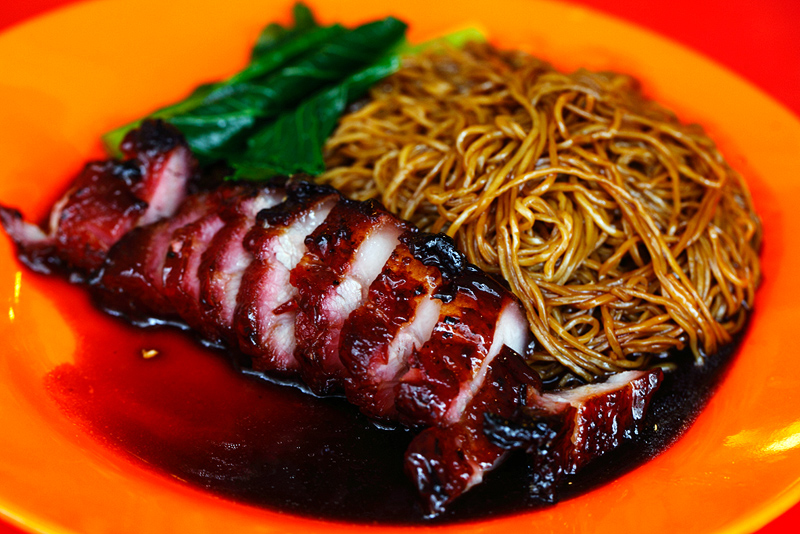Penang, a vibrant island state located in Malaysia, is widely celebrated as a food lover’s paradise. Its unique culinary scene offers a diverse range of flavors and influences, reflecting its rich multicultural heritage. Penang food is renowned for its bold and harmonious blend of Chinese, Malay, Indian, and Nyonya (Straits Chinese) flavors, resulting in a delightful fusion of tastes and textures.
Penang’s street food culture is particularly famous, with bustling hawker centers and roadside stalls lining the streets. These informal and lively settings offer an array of delectable dishes that locals and visitors can savor at affordable prices. From savory noodle dishes to mouthwatering snacks and desserts, Penang street food showcases the depth and diversity of its culinary traditions. This post introduction with you about Penang Food Guide: Must Eat Food and Where to Find Them.
Penang Char Koay Teow
Penang Char Koay Teow is a famous local dish that originated from Penang, Malaysia. It is a stir-fried noodle dish that is immensely popular among locals and tourists alike.
Char Koay Teow is made with flat rice noodles, commonly known as “koay teow,” which are stir-fried over high heat with various ingredients. The dish typically includes ingredients such as shrimp, cockles, bean sprouts, Chinese sausage, eggs, and chives. These ingredients are seasoned with a combination of soy sauce, chili paste, and sometimes belacan (shrimp paste) to give it a savory and slightly spicy flavor.
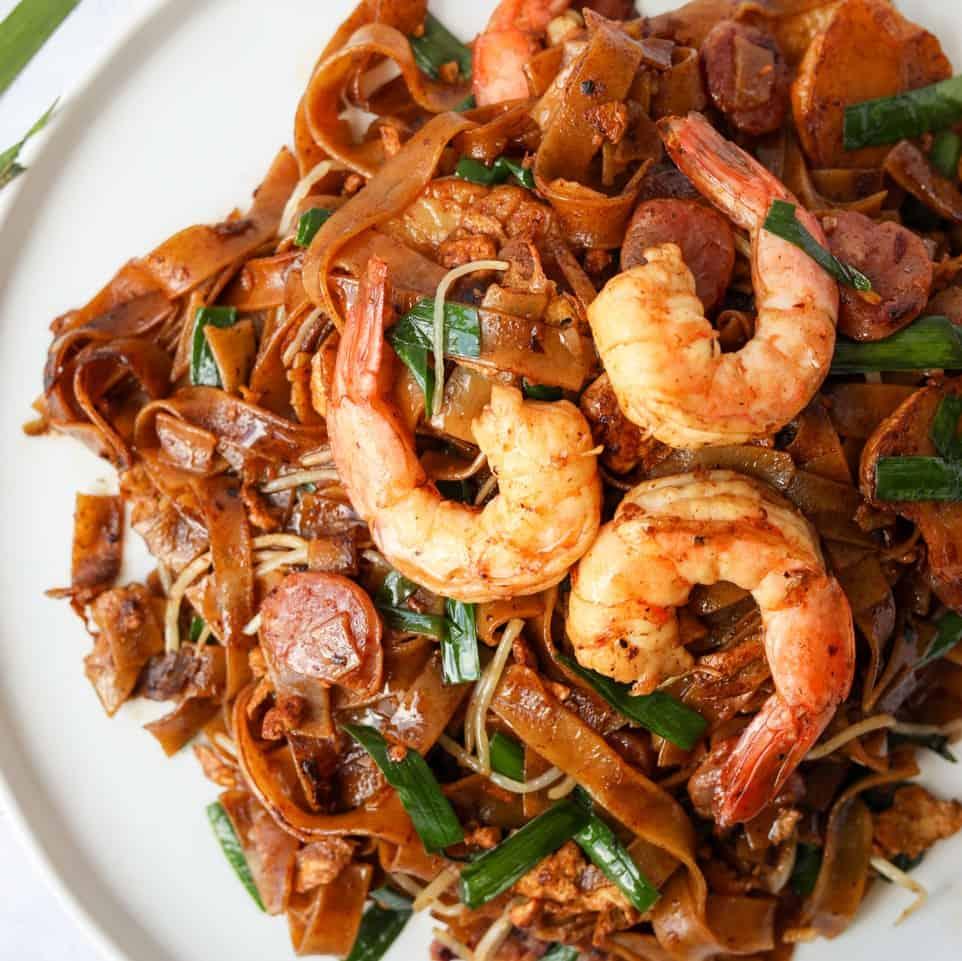
What sets Penang Char Koay Teow apart is the “wok hei” or “breath of the wok” flavor. This term refers to the smoky and slightly charred taste that comes from cooking the noodles over intense heat in a large wok. The skilled and experienced Char Koay Teow hawkers in Penang are known for their ability to achieve the perfect wok hei, resulting in a delicious and flavorful dish.
To savor authentic Penang Char Koay Teow, you can find it in various hawker centers, street food stalls, and local restaurants across the island. Some famous places to try this dish include Lorong Selamat, Siam Road, and the Air Itam market. These locations are well-known for their Char Koay Teow, attracting both locals and visitors in search of this Penang delicacy.
Penang Char Koay Teow is a must-try when visiting Penang as it represents the unique flavors and culinary heritage of the region. The combination of the smoky wok hei, the rich flavors of the ingredients, and the skillful preparation make it a beloved dish that captures the essence of Penang’s food culture.
Where to eat Penang Char Koay Teow
- Kafe Heng Huat
- Ah Leng Char Koay Teow
Penang Asam Laksa
Penang Asam Laksa is a popular and iconic dish that is considered one of Penang’s most beloved culinary treasures. It is a tangy and flavorful noodle soup that combines the richness of fish broth with a unique blend of spices and ingredients.
Asam Laksa is made using thick rice noodles that are served in a savory and sour fish-based broth. The broth is prepared by simmering fish, typically mackerel or sardines, with a blend of aromatic ingredients such as tamarind, lemongrass, galangal, and torch ginger flower. These ingredients give the soup its distinctive tangy and slightly sour flavor.
The dish is typically garnished with a variety of toppings, including finely sliced cucumber, pineapple, red onions, mint leaves, and a spoonful of thick shrimp paste called “hae ko.” The combination of these toppings adds a refreshing and vibrant element to the dish, balancing the sourness of the broth.

To enjoy Penang Asam Laksa, it is best to visit hawker centers or street food stalls where you can find authentic versions of this dish. One popular spot to try Penang Asam Laksa is the Air Itam market, which is known for its delicious and flavorful rendition. Another famous location is the Balik Pulau area, where you can find stalls serving this iconic dish.
Penang Asam Laksa is a unique and delicious culinary experience that showcases the flavors and cultural heritage of Penang. Its tangy and refreshing taste, combined with the umami of the fish broth and the medley of toppings, make it a must-try dish for any food lover visiting Penang.
Where to eat Penang Asam Laksa
- Air Itam Asam Laksa
Penang Tau Sar Piah
Penang Tau Sar Piah is a popular traditional pastry that originated from Penang, Malaysia. It is a flaky and savory pastry filled with a sweet and fragrant mung bean paste.
The name “Tau Sar Piah” translates to “bean paste biscuit” in the Hokkien dialect, which is widely spoken in Penang. The pastry is made with a combination of wheat flour, oil, and water, resulting in a delicate and crispy outer crust when baked.
The filling of Penang Tau Sar Piah is made from mung beans, which are cooked and mashed with sugar, lard, and other flavorings. The mung bean paste is then wrapped in the pastry dough and shaped into small round or oval shapes. The pastries are often topped with sesame seeds before baking, adding a nutty aroma and texture to the final product.
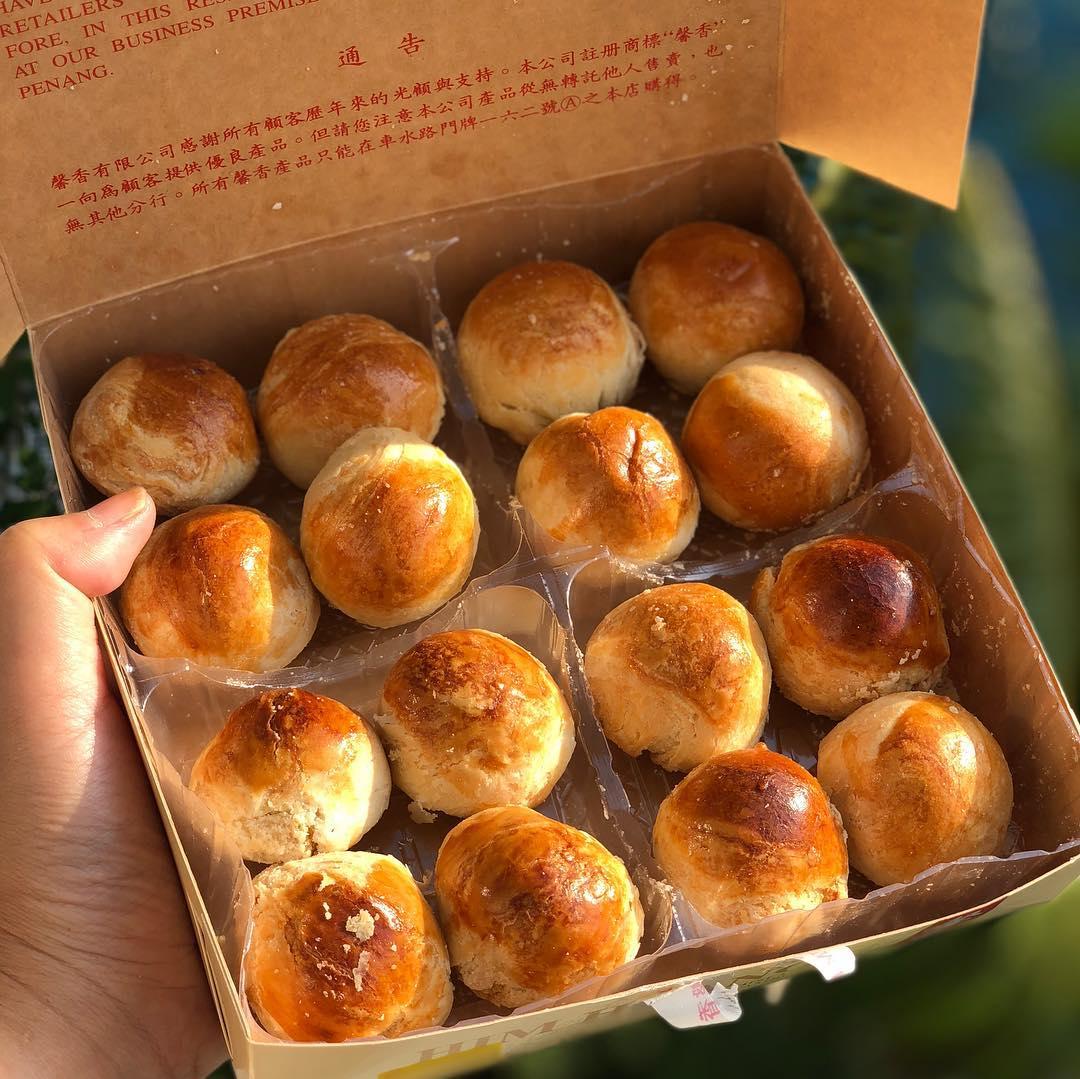
Penang Tau Sar Piah is known for its unique combination of textures and flavors. The flaky pastry provides a satisfying crunch, while the sweet and fragrant mung bean filling offers a delightful contrast. The balance of sweetness and savory notes makes it a favorite snack or gift item among locals and tourists alike.
To find Penang Tau Sar Piah, you can visit traditional bakeries and specialty shops in Penang. Some well-known places to purchase these pastries include Him Heang, Ghee Hiang, and Kheng Pin Café. These establishments have been producing and selling Penang Tau Sar Piah for generations, maintaining the authenticity and quality of this beloved local treat.
Penang Tau Sar Piah is not only a delicious snack but also a cultural symbol of Penang’s culinary heritage. It is a delightful souvenir to bring back home or enjoy while exploring the streets of Penang, immersing yourself in the rich flavors and traditions of the island.
Where to get Tau Sar Piah in Penang
- Tean Ean Tau Sar Piah
- Him Heang
Nasi Lemak
Nasi Lemak is a popular and beloved Malaysian dish that is considered the national dish of Malaysia. It is a fragrant and flavorful rice dish cooked in coconut milk and served with a variety of accompaniments.
The core component of Nasi Lemak is the rice, which is cooked with coconut milk, pandan leaves, and spices such as ginger and lemongrass. This cooking process infuses the rice with a rich and aromatic flavor, giving it a slightly sweet and creamy taste.
Nasi Lemak is typically served with a variety of accompaniments and condiments. The most common accompaniments include:
1. Sambal: A spicy chili paste made from a combination of chili peppers, shrimp paste, onions, and garlic. Sambal adds a fiery kick and enhances the overall flavor of the dish.
2. Fried or Grilled Chicken: Often served as a side dish or as a main protein, the chicken is marinated in spices and then fried or grilled to perfection. It adds a savory element to the meal.
3. Hard-boiled or Fried Egg: Eggs are a common addition to Nasi Lemak, either boiled or fried sunny-side-up. The soft yolk of a boiled egg or the runny yolk of a fried egg complements the fragrant rice.
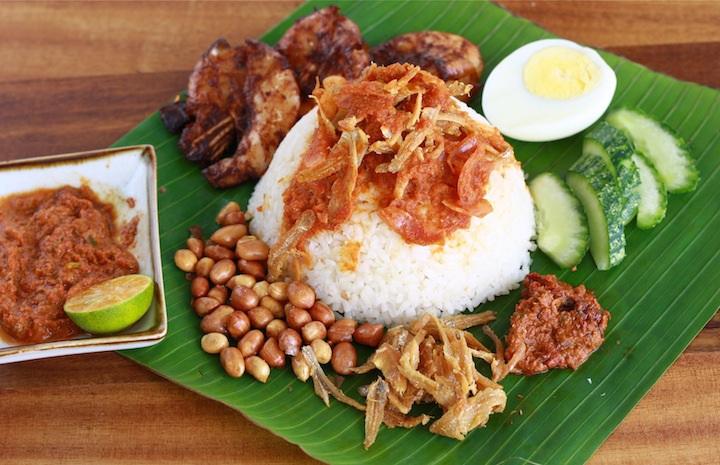
4. Fried Anchovies and Peanuts: Crispy fried anchovies (ikan bilis) and peanuts provide a crunchy texture and a touch of saltiness to balance the flavors of the dish.
5. Cucumber: Slices of fresh cucumber are often included as a refreshing accompaniment to cut through the richness of the coconut rice and sambal.
Nasi Lemak is widely available in Malaysia, from street food stalls to restaurants and even in some hotel breakfast spreads. It is commonly enjoyed as a breakfast dish but can be savored at any time of the day. The versatility and combination of flavors make it a satisfying and comforting meal for Malaysians and visitors alike.
Nasi Lemak has become an integral part of Malaysian cuisine and is celebrated for its unique blend of aromatic rice, spicy sambal, and delicious accompaniments. It is a must-try dish that showcases the rich culinary heritage and diverse flavors of Malaysia.
Where to eat Nasi Lemak in Penang
- Nasi Lemak Cili Bilis at Gurney Drive for RM 3.50!
Kueh Pie Tee and Popiah
Kueh Pie Tee and Popiah are two popular and delicious Malaysian snacks that are often enjoyed as appetizers or light meals. They both have Chinese origins but have become beloved dishes in Malaysia, including in Penang.
Kueh Pie Tee, also known as Top Hats, are bite-sized crispy pastry cups filled with a savory mixture of vegetables, usually consisting of julienned turnips (commonly known as “bangkuang” or “jicama”), carrots, and sometimes cooked shrimp or chicken. The filling is seasoned with soy sauce, oyster sauce, and various spices, creating a flavorful combination. Kueh Pie Tee cups are typically assembled just before serving to ensure the crispness of the pastry.
Popiah, on the other hand, is a fresh spring roll filled with a medley of vegetables, cooked meat (such as pork or chicken), and other ingredients. The key component of Popiah is the paper-thin crepe-like skin, made from a mixture of flour and water. The skin is spread with a sweet hoisin sauce and filled with julienned vegetables, bean sprouts, tofu, chopped peanuts, and sometimes prawns. The roll is then wrapped tightly and cut into smaller portions before serving.

Both Kueh Pie Tee and Popiah are typically enjoyed by adding condiments and garnishes. These can include chili sauce, garlic chili sauce, chopped cilantro, and crushed peanuts, among others. The condiments add extra flavor and texture to the already delicious snacks.
You can find Kueh Pie Tee and Popiah in various hawker centers, food stalls, and restaurants throughout Malaysia, including Penang. Some popular places to try these snacks in Penang include Gurney Drive Hawker Center, New Lane Hawker Center, and Chowrasta Market.
Kueh Pie Tee and Popiah are delightful treats that showcase the influence of Chinese cuisine on Malaysian food culture. They offer a combination of textures, flavors, and freshness that make them a delightful and satisfying choice for snacking or as part of a meal.
Where to get Koay Pai Ti and Popiah in Penang
- Gurney Drive
- Ong Leng Hin’s Chinese Popiah in Padang Brown Hawker
- Popiah Penang Chowrasta
Oyster Omelette
Oyster Omelette, also known as Orh Luak or Oh Chien, is a popular dish in many Asian cuisines, including Malaysian and Taiwanese cuisine. It is a flavorful and indulgent omelette made with a combination of eggs, starch, and fresh oysters.
To prepare Oyster Omelette, a batter is first made by mixing eggs with a starch, such as tapioca or potato starch, to give it a slightly chewy texture. The batter is then poured onto a hot greased pan or wok, creating a thick pancake-like base.
Fresh oysters are then added to the batter, and the omelette is cooked until the edges become crispy and golden brown while the center remains slightly gooey. The oysters become tender and release their briny flavor into the omelette, enhancing its taste.
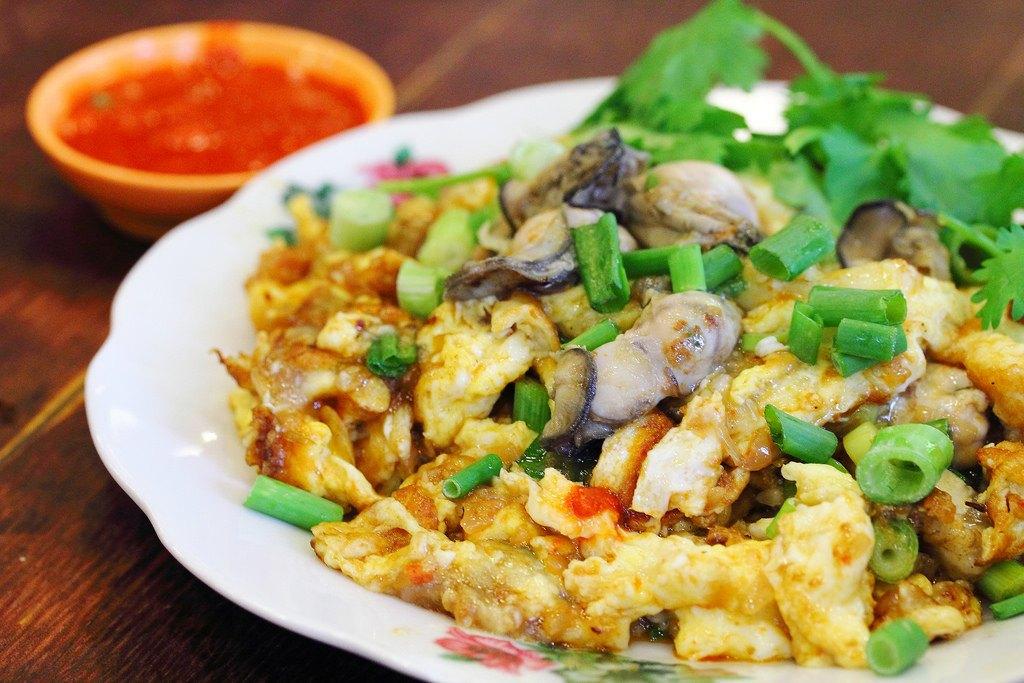
Oyster Omelette is commonly served with a tangy and spicy dipping sauce. This sauce is typically made with a combination of chili sauce, soy sauce, vinegar, and sometimes garlic or lime juice. The sauce complements the rich and savory flavors of the omelette, adding a delightful contrast of flavors.
In Malaysia, you can find Oyster Omelette in various hawker centers, street food stalls, and seafood restaurants, especially in coastal regions. Some popular places to try Oyster Omelette in Penang include Gurney Drive Hawker Center and New Lane Hawker Center.
Oyster Omelette is a beloved dish that offers a combination of textures and flavors. The crispy edges of the omelette, the tender oysters, and the tangy dipping sauce create a satisfying and mouthwatering experience. It is a must-try dish for seafood lovers and those seeking to explore the rich culinary traditions of Malaysia.
Where to get Oyster Omelette in Penang
- Kafe Heng Huat in Lorong Selamat
Otak-Otak
Otak-Otak is a flavorful and aromatic dish that is commonly found in Southeast Asian cuisine, including in Malaysia, Singapore, and Indonesia. It is a type of fish cake or fish mousse that is wrapped in a banana leaf and grilled or steamed, resulting in a smoky and fragrant delicacy.
The main ingredient of Otak-Otak is typically fish, such as mackerel or threadfin, which is finely minced or blended into a paste. The fish paste is then mixed with a variety of aromatic herbs and spices, including shallots, garlic, lemongrass, galangal, turmeric, chili, and coconut milk. This combination of ingredients gives Otak-Otak its distinctive taste and aroma.
The fish mixture is traditionally wrapped in a banana leaf, which not only imparts a subtle earthy flavor to the dish but also helps to hold the delicate fish cake together during cooking. The wrapped parcels are then grilled over charcoal or steamed until the fish cake becomes firm and cooked through.

The flavors of Otak-Otak are a harmonious blend of the natural sweetness of the fish, the fragrant spices, and the creaminess of the coconut milk. The dish has a slightly spicy kick, depending on the amount of chili used, and is usually served as an appetizer or snack.
You can find Otak-Otak in various hawker centers, street food stalls, and seafood restaurants in Malaysia, especially in coastal regions like Penang. Some popular places to try Otak-Otak in Penang include Gurney Drive Hawker Center, Pulau Tikus Market, and Balik Pulau area.
Otak-Otak is a delightful dish that showcases the richness and complexity of Southeast Asian flavors. Its unique blend of ingredients and the cooking method of grilling or steaming in banana leaves make it a delicious and memorable culinary experience for food enthusiasts.
Where to get Otak Otak in Penang
- Kafe Heng Huat in Lorong Selamat
Wantan Mee
Wantan Mee, also known as Wanton Noodles, is a popular Chinese noodle dish that is commonly found in Malaysia, Singapore, and Hong Kong. It is a versatile and comforting dish that features springy egg noodles served with a variety of toppings and a savory sauce.
The key components of Wantan Mee are the noodles and the wantan (wonton) dumplings. The noodles used are usually thin and egg-based, giving them a springy texture when cooked. The wantan dumplings are made from a mixture of minced pork, shrimp, and various seasonings, wrapped in a thin dough skin.
To prepare Wantan Mee, the noodles are typically blanched in boiling water until cooked, then drained and tossed in a combination of sauces. The sauces can vary but commonly include a mixture of soy sauce, oyster sauce, sesame oil, and sometimes chili sauce for added spiciness. This sauce coating adds flavor and helps prevent the noodles from sticking together.
The wantan dumplings are usually boiled separately and served alongside the noodles. They can also be fried or steamed, depending on personal preference. The dumplings are delicate and filled with a savory mixture, offering a delicious contrast to the noodles.
Wantan Mee can be enjoyed in various styles and with different toppings. Common toppings include slices of char siu (barbecued pork), blanched leafy greens such as bok choy or choy sum, and sometimes crispy pork lard or fried shallots for added texture and flavor.
You can find Wantan Mee in many hawker centers, street food stalls, and Chinese restaurants throughout Malaysia, including Penang. Some popular places to try Wantan Mee in Penang include Genting Cafe, Lebuh Presgrave Wantan Mee, and Pulau Tikus Market.
Wantan Mee is a beloved comfort food that offers a delightful combination of flavors and textures. The springy noodles, savory wantan dumplings, and flavorful sauce create a satisfying and comforting meal that is enjoyed by locals and visitors alike.
Where to get Wantan Mee in Penang
- Ah Hock Wantan Mee
- Maria’s Sui Kow Wan Tan Mee
Hokkien Prawn Mee
Hokkien Prawn Mee, also known as Har Mee, is a popular noodle dish that originated from the Hokkien Chinese community in Malaysia and Singapore. It is a flavorful and hearty dish that combines noodles with a rich and savory broth, prawns, and other delicious ingredients.
The key elements of Hokkien Prawn Mee are the noodles and the broth. The noodles used can vary but commonly include thick yellow noodles and thin rice vermicelli, giving the dish a mix of textures. The broth is typically made from a combination of prawn shells, pork bones, and other aromatics such as garlic, shallots, and dried shrimp. This broth is simmered for hours to extract the flavors and create a robust and savory base.
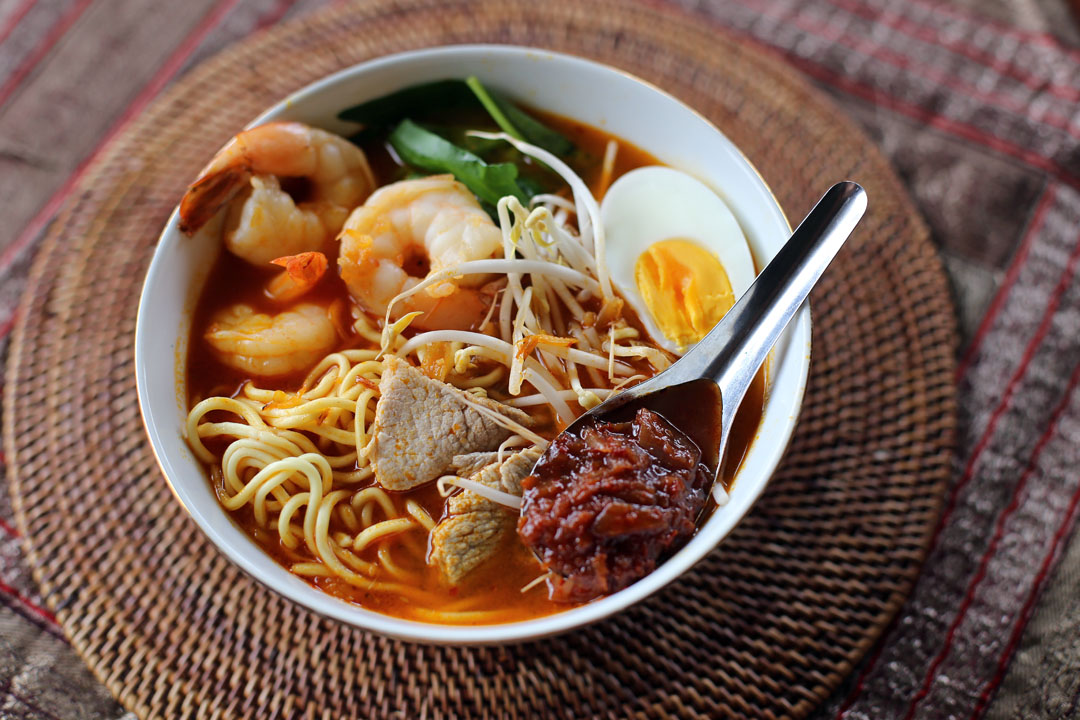
Hokkien Prawn Mee is traditionally served with a variety of toppings and condiments. The most important ingredient is the prawns, which are usually cooked in the broth to infuse them with the rich flavors. Other common toppings include slices of pork or chicken, squid, fish cake, and sometimes hard-boiled egg. The dish is often garnished with fried shallots, chopped spring onions, and a squeeze of lime for a refreshing tang.
To enjoy Hokkien Prawn Mee, diners typically mix the noodles and toppings in the broth before taking a spoonful of the flavorful soup. The combination of the savory broth, succulent prawns, and well-cooked noodles creates a satisfying and comforting experience.
Hokkien Prawn Mee can be found in hawker centers, street food stalls, and local seafood restaurants throughout Malaysia, including Penang. Some popular places to try Hokkien Prawn Mee in Penang include Kim Leng Hokkien Mee, Kedai Kopi Swee Kong, and 888 Hokkien Mee.
Hokkien Prawn Mee is a delicious representation of Hokkien cuisine and is loved for its robust flavors and comforting qualities. It is a must-try dish for noodle lovers and those seeking to explore the diverse culinary offerings of Malaysia.

